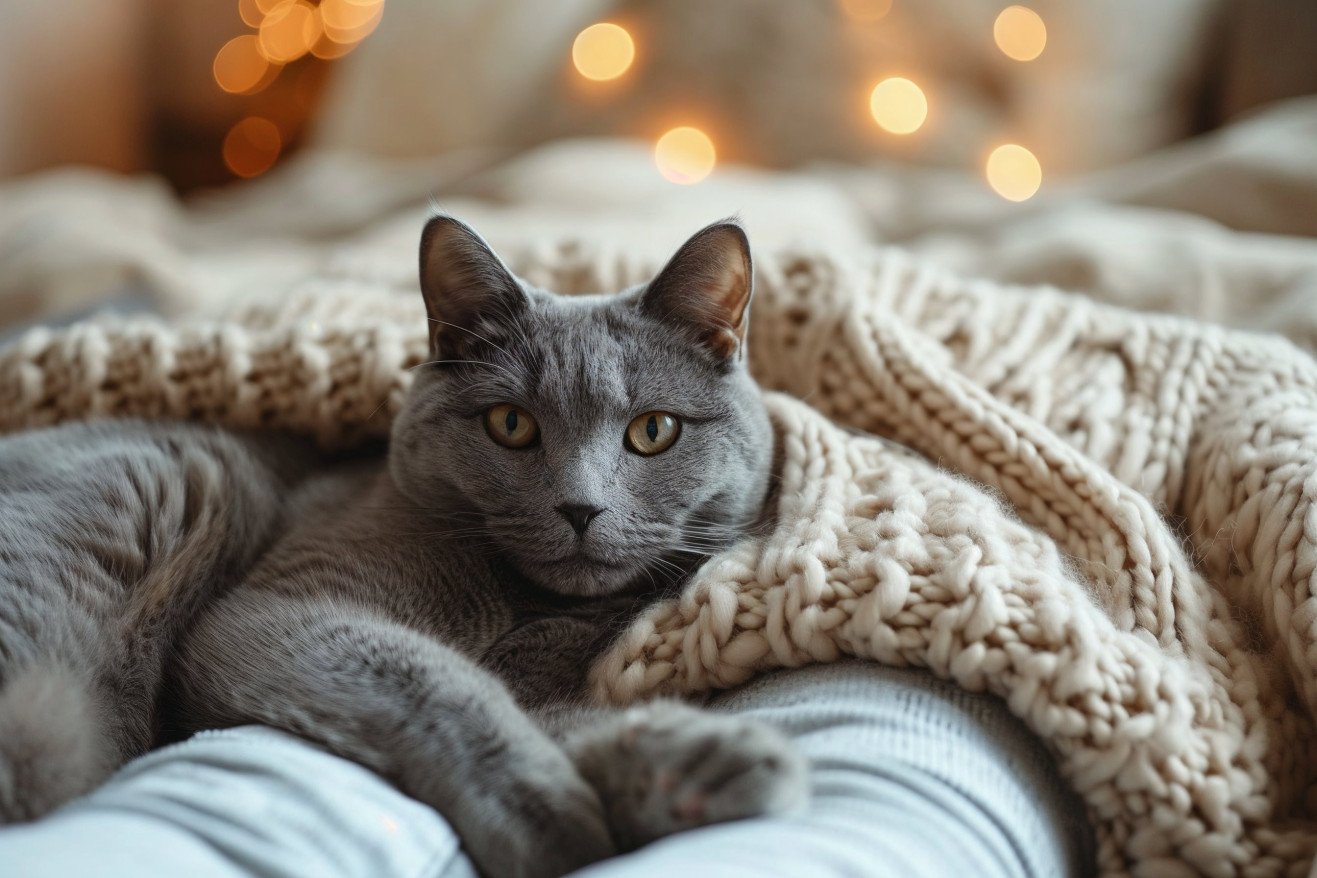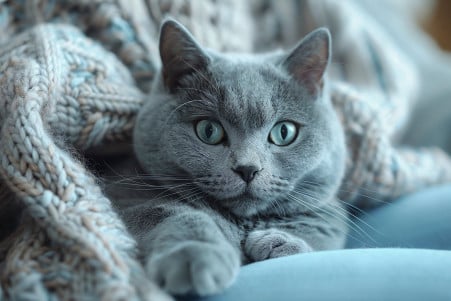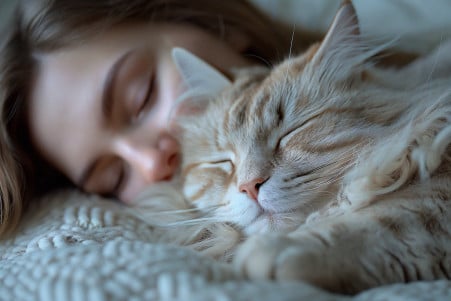Why Does My Cat Sleep by My Feet? Science Explains the Relationship Behind the Behavior
7 February 2024 • Updated 7 February 2024

If your cat sleeps by your feet every night, you may wonder why they do it. While it may seem like an odd behavior to you, there are several reasons why your cat may choose to sleep in this particular spot.
Cats sleep by their owners’ feet to stay warm, feel safe, and bond with their humans. This position allows them to stay close to you and feel safe while also staying alert to any potential threats or changes in their environment, which reinforces their natural instincts.
To better understand why your cat prefers to sleep by your feet, this article will explore a variety of scientific studies from the fields of animal behavior, psychology, and veterinary science. These studies shed light on the many factors, including instinct, comfort, and bonding, that influence where a cat chooses to sleep. By learning about these factors, you’ll come to understand your cat’s behaviors and your relationship with them in a whole new way.
Why does my cat sleep by my feet?
The Temperature Factor: Physiological Need for Warmth
In addition to seeking warmth for comfort, cats also have a physiological need to stay warm because of their higher body temperature. Dr. Jan Huntingford explains that cats, who have a body temperature of around 101.5 degrees Fahrenheit, are drawn to warm places. This means that your cat is likely to find comfort at the foot of your bed, where they can take advantage of your body heat to stay warm while they sleep.
K&H Pet Products recommends that cat parents help their pets meet their need for warmth by using heated beds and self-warming pads. This not only meets a cat’s need for warmth but also gives them a safe, comfortable place to relax.
Cats are drawn to the foot of the bed because it’s one of the warmest places, thanks to their owners’ body heat. Of course, the heat you provide also meets their need for a safe, warm place, which helps strengthen your bond with your cat.
The Science of Purring: What It Means When Your Cat Sleeps on Your Feet
Even though cats are often thought of as independent and aloof, a study from Oregon State University found that cats form attachments to their owners that are similar to the bonds that dogs and human babies form.
So, when it comes to why your cat sleeps on your feet, the emotional answer is that your cat wants to be close to you and feels secure with you. In fact, ScienceAlert found that more than 60% of cats show a secure attachment to their owners by staying close to them in unfamiliar situations.
This secure attachment goes beyond physical closeness to show that cats form emotional attachments to their owners. Cats also show signs of distress when their owners leave them, and they greet them and seek comfort when they return. This is similar to the way dogs and human children form attachments to their parents. The similarities and differences in the way different species form attachments show that animals form complex emotional bonds.
The way that owners view their relationships with their cats can also have a big impact on their behavior. A study published in PMC found that the type of relationship that owners believe they have with their cats—open, co-dependent, or friendship—impacts the way that cats interact with their owners.
This emotional context may help explain why so many cats find the area by your feet, which is warm and secure, the perfect place to sleep.
Biological and Developmental Factors
The first factor that may explain why cats like to sleep at the foot of the bed has to do with their biology and the way their sleep patterns are established.
First, cats, like humans, go through different sleep cycles that affect their sleep patterns. A study published in Brain Research found that cats go through distinct sleep cycles that include rapid eye movement (REM) sleep and two stages of slow-wave sleep, which is similar to the light and deep sleep that humans experience.
The comfort and security provided by the foot of the bed may meet their sleep needs, as it offers a combination of warmth, closeness to their human, and the ability to respond to potential threats or disturbances.
In addition, the establishment of these sleep patterns starts early in a cat’s life.
A study published in PubMed, a study by Johnson et al., found that kittens start to show adult-like bi-cyclic sleep patterns around day 30 of development, with changes in REM and non-REM sleep happening in conjunction with increased activity and maternal interaction.
This pattern of seeking out secure, comfortable places to sleep is then carried into adulthood, with the foot of the bed often becoming a preferred spot because it meets these criteria. It’s a place where they can feel safe and let their guard down while still being ready to respond if their instincts tell them to.
Instinctual Behavior: Seeking Safety and Security
Instinctual behaviors that are rooted in a need for safety and security are present in cats and harken back to their days in the wild. As explained in Cats and their Ancestral Instincts, these behaviors can be seen in the places cats choose to sleep, like near the feet of their owners—places that make them feel safe and secure.
In this way, cats may be using their human relationships as a modern way to survive, creating a hidden safe space from which they can keep an eye on their surroundings and quickly respond to any threats.
Owners are an important source of safety for cats when they’re sleeping, as this is when they’re most vulnerable.
As noted by Hillspet, cats see their human owners as part of their family, which means they feel safe and secure with their protective presence.
In other words, the foot of the bed is a place of safety, not just warmth, where a cat’s ancestral instincts and need for security come together, allowing the cat to relax and recharge for its nighttime activities.
Tactile Preferences and Comfort
In the complex world of feline senses, touch is one of the most important ways cats experience their surroundings. According to Cat Behaviours, the importance of touch starts at birth and impacts a cat’s growth and daily life based on the tactile experiences they have.
In fact, cats are so sensitive to touch that they have specialized touch receptors called Pinkus’ corpuscles that are spread throughout their skin and help them determine the feel of different textures and materials.
Tactile experiences are also a big part of where a cat chooses to sleep. Your cat may find the softness of the blankets at the end of your bed or the pressure of your feet under the covers comforting.
Touch is not only how cats move through the physical world, but it’s also how they find emotional comfort. In fact, the article Understanding Feline Communication from the WSAVA 2014 Congress explains that physical touch, such as rubbing and bunting, is one of the primary ways cats show affection and contentment.
So when cats seek out their owners for physical contact, they are looking for more than just warmth and security, they are also looking for tactile comfort. The feeling of pressing against their owner’s feet may be comforting and soothing to cats, helping them meet their need for sensory comfort.
The role of texture and touch in cat behavior shows that cats’ preferences are complex and multi-faceted, including both the physical and emotional aspects of their comfort.
History Lesson: How Domestication Has Shaped Cat Behavior
The history of cat domestication, which dates back thousands of years, has had a lasting impact on the way cats behave today. According to Scientific American, this history can be traced to the Near East, where cats first started living near humans as a way to catch rodents in early agricultural communities.
This mutually beneficial relationship helped lead to the domestication of cats, which, according to National Geographic, happened through a process of self-domestication. The domestication of cats likely influenced their sleeping patterns, including their preference for sleeping near their owners’ feet, which can be seen as a safe zone similar to the perimeters of the ancient granaries where their ancestors lived.
The history of cat domestication is closely tied to human history and has led to behaviors that have helped cats live with humans. According to Smithsonian Magazine, the fact that cats were useful in controlling pests helped ensure their place in human communities.
As a result, the modern domestic cat has innate behaviors that reflect this history, including a preference for seeking out safe, warm places that are similar to the ones their ancestors lived in. This is why the foot of the bed is such a popular place for cats to sleep.
This history shows that cats have evolved to be companions who value the presence and protection of their human owners, which explains the close and protective spot by your feet. As we learn more about this bond, it’s a good reminder of the deep and long-lasting history that has shaped the lives of our feline companions.
The Mystery of the Cat Sleeping at the Foot of the Bed: An Overview
We have delved into the many complex reasons why a cat might choose to sleep at the foot of their human’s bed, from the simple fact that cats have a higher body temperature and are attracted to warmth to the secure attachment theory that is so often used to explain human relationships.
Our look at the way cats sleep has shown that the comfort and security of the foot of the bed lines up with the type of environment that cats prefer when they are sleeping.
Instinct also drives cats to sleep near their human protectors, as they seek safety and security during their most vulnerable time of day. The physical contact that comes with sleeping at the foot of the bed also meets their sensory needs.
At the same time, this behavior is also an echo of the past, a remnant of the process of domestication that has shaped cats’ preferences and behaviors. So, when your cat curls up at the foot of your bed each night, it’s not just because they are seeking warmth or security, it’s also because they are expressing a deep connection that has been forged over thousands of years.
Recognizing and appreciating these traits in our cats can help us better understand and bond with these enigmatic animals. Their decision to sleep at our feet is a small, daily reminder of the many layers of our enduring relationship.


